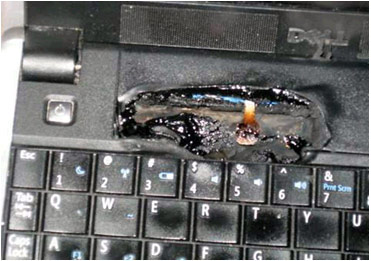Safety Concerns with Li-ion
Safety is a sensitive issue that gets much media and legal attention, especially with Li-ion batteries. Any energy storage device carries a risk, and in the 1800s steam engines exploded and people got hurt. Carrying highly flammable gasoline in cars was a hot topic in the early 1900s. Battery makers are obligated to meet safety requirements, but less reputable firms may cheat — it’s “buyers be beware!” Most OEMs use only Li-ion batteries that comply with one or several safety standards.
Lithium-ion has a high specific energy and even though safe, high usage by millions of consumers is bound to generate failures. In 2006, a one-in-200,000 breakdown triggered a recall of almost six million lithium-ion packs. Heat-related battery failures are taken very seriously, and manufacturers choose a conservative approach. Let’s examine this closer.
Sony, the maker of the lithium-ion cells in question, points out that on rare occasions microscopic metal particles may come into contact with other parts of the battery cell, leading to a short circuit within the cell. Battery manufacturers strive to minimize the presence of such particles; however, complex assembly techniques make the elimination of all metallic dust nearly impossible. Cells with ultra-thin separators of only 20–25µm are more susceptible to impurities than the older designs with lower Ah ratings. Whereas the 1,350mAh cell in the 18650 package could tolerate the nail penetration test, the high-density 2,400mAh becomes a bomb when performing the same test. New safety standards are more lifelike and the UL1642 Underwriters Laboratories (UL) test no longer mandates nail penetration for safety acceptance of lithium-based batteries.
Li-ion using conventional metal oxides is nearing its theoretical limit on specific energy. Rather than optimizing runtime, battery makers are improving manufacturing methods to enhance safety and increase the calendar life. The real problem lies in rare occasions when an electrical short develops inside the cell. In such a case, the external protection peripherals are ineffective to stop the thermal runaway, once in progress. The batteries recalled in 2006 passed the UL safety requirements — yet they failed in normal use.
Let’s examine the inner workings of the cell closer. A mild short will only cause elevated self-discharge and the heat buildup is minimal because the discharging power is very low. If, however, enough microscopic metallic particles converge on one spot, a sizable current begins to flow between the electrodes of the cell, and the spot heats up.
Uneven separators may also trigger cell failure. Poor conductivity due to dry area increases the resistance, which can generate local heat spots that weaken the integrity of the separator. Heat is always an enemy of the battery. When fully charged, elevated temperature causes a harmful reaction between the positive and negative electrodes and the electrolyte. As a small water leak in a faulty hydro dam can develop to a torrent and take a structure down, so also can heat buildup damage the insulation layer in a cell and cause an electrical short. The temperature can quickly reach 500°C (932°F), at which point the cell catches fire or explodes. This thermal runaway that occurs is known as “venting with flame.” “Rapid disassembly” is the preferred term by the battery industry.
If the sony battery gets very hot, immediately remove the device from proximity to flammable materials and bring it to a non-combustible surface. If at all possible, put a disintegrating laptop or cell phone outdoors and let it burn out. If the fire occurs in an airplane, FAA tells flight attendants not to use fire extinguishers but specify water or pop (soda). Water cools the adjacent material and prevents the fire from spreading. Many research laboratories and factories also use water to put out battery fires. Allow good ventilation while the battery burns itself out. Li-ion contains no lithium metal and does not react with water. A fire with batteries containing lithium metal requires a different extinguishing method.
During a thermal runaway, the high heat of the failing cell may propagate to the next cells, causing them to become thermally unstable also. A chain reaction can occur in which each cell disintegrates on its own timetable. A pack can thus be destroyed in a few seconds or over several hours as each cell is being consumed one by one. To increase safety, packs should include dividers to protect the failing cell from spreading to the neighboring one. (In the Tesla Roadster car, each cell is encased in its own metal compartment.) Figure shows a laptop that was damaged by a faulty Li-ion battery.
| |
Figure: Suspected Li-ion battery destroys laptop The owner says the laptop popped, hissed, sizzled and began filling the room with smoke. Courtesy of Shmuel De-Leon
|
While Li-ion is being scrutinized for safety, other chemistries also have problems. Nickel- and lead-based batteries cause fires too, and some are being recalled. The reasons of these failures are faulty separators resulting from aging, rough handling, excessive vibration and high-temperature.
Let me assure you that lithium-ion batteries are safe and that heat-related failures are rare. While the safety measures are especially critical for larger multi-cell batteries, small packs for cell phones need fewer safety precautions.

